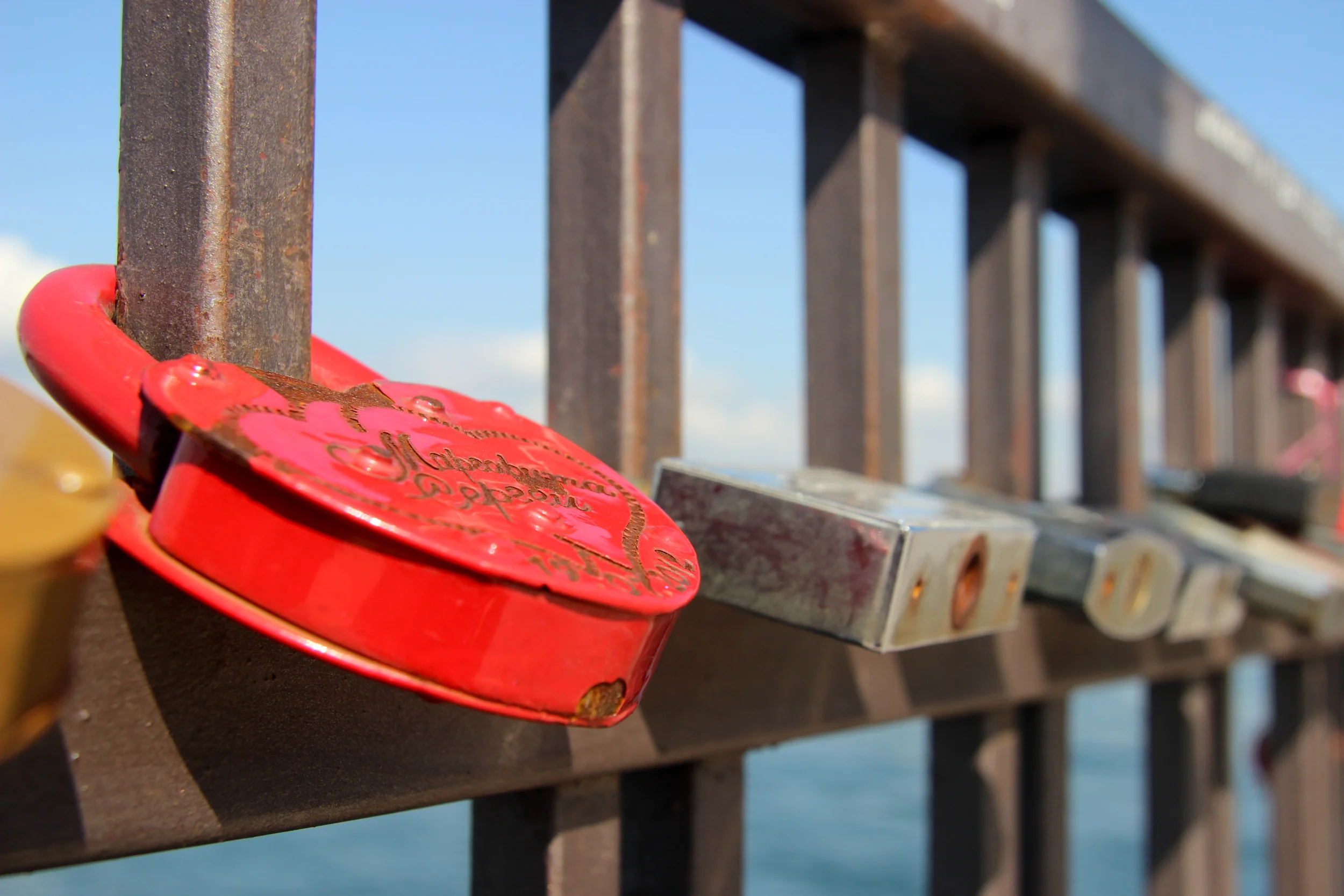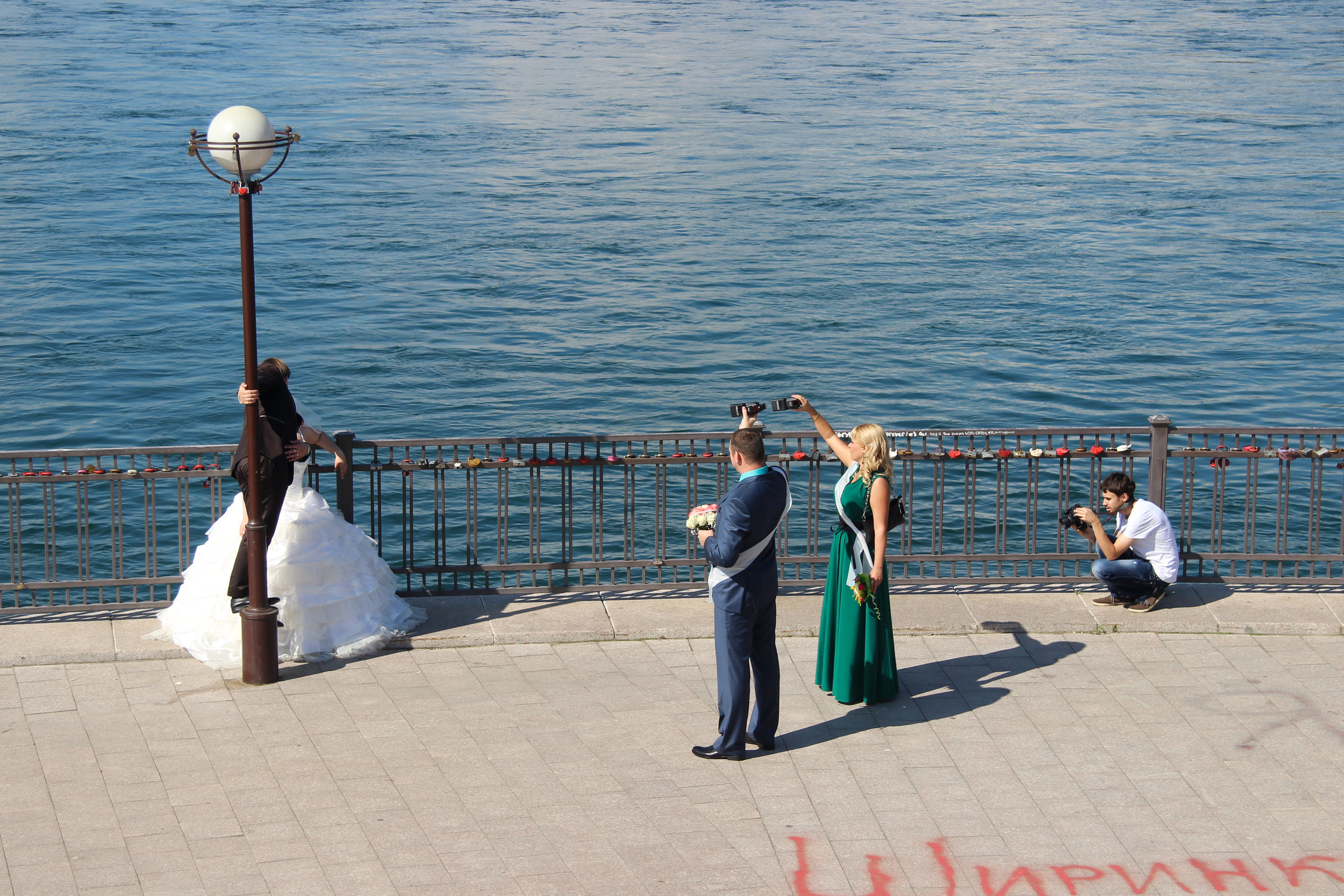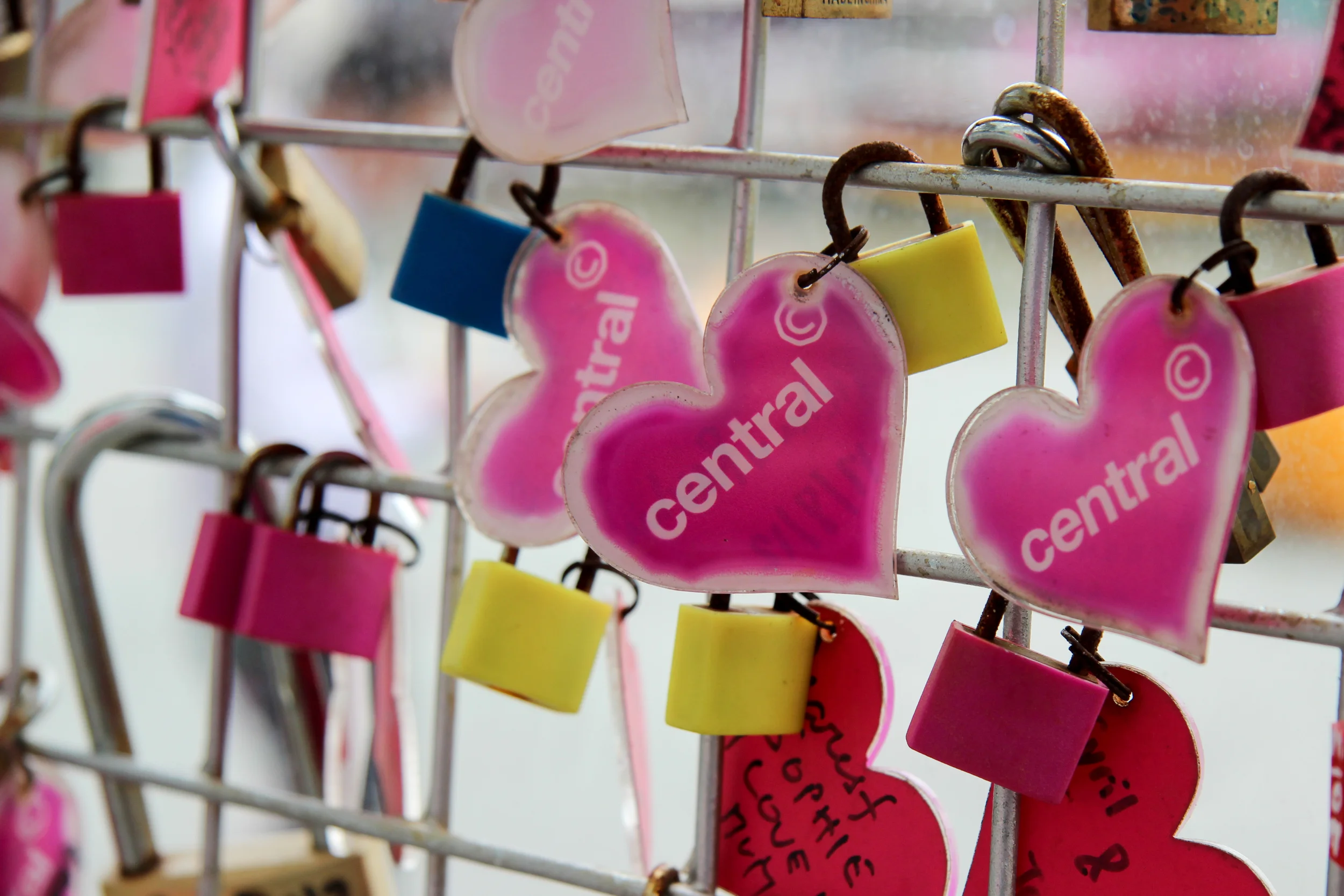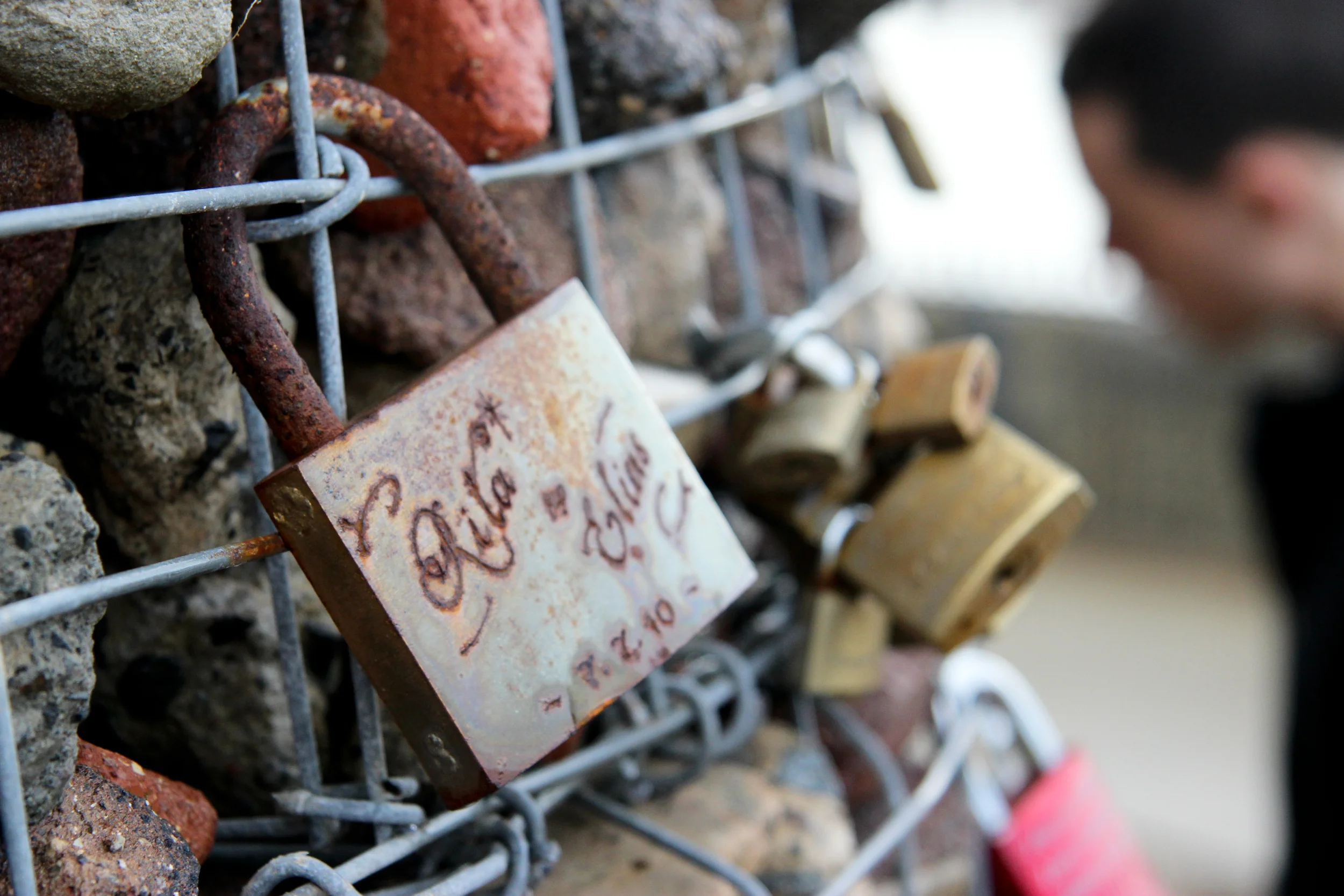The Rise and Rusting of Love Locks
A couple approaches the edge of the Angara River, coursing through the city of Irkutsk en route to the vast Lake Baikal in the east. It is a warm, sunny Saturday in the heart of Siberia – an alignment of date and season that brings out the multitudes for wedding photos. Squinting tourists and strolling citizens alike are outnumbered by the small roving bands of brides and bridesmaids, grooms and groomsmen, proud parents and casually clothed photographers descending on the waterfront.
This couple is no different; a grinning, full-faced pair flanked by a party decked in blue and emerald. At the water’s edge they kiss, chaste and slow for the clicking cameras, at last hungrily for themselves.
With a ceremonial flourish the best man pulls a large red lock fashioned in the shape of a heart from his coat, and passes it to the bride and groom. The newlyweds’ hands entwine together around the hunk of cheap metal, inscribed with their names and the fortunate date. They grin as they clasp the lock, giggle as they secure it to the pallid steel fence and kiss as the groom opens his palm above the precipice and lets the key drop into the river.
Applause follows, as does the spate of pictures on mobiles and pocket cameras, before the party decamps to the nearby war memorial for another round. It is just as well; another happy pair in their formal blacks and florid whites await their turn.
Love locks have penetrated as far as Russia’s east-most provinces, and in the process been invested with all the trappings of ritual; a bright, boutique lock is almost as essential as the rings, parent-pleasing Orthodox priest or a case of vodka at the reception. Yet the idea has not travelled far from the gesture of an imagined eternity given life by romantic teens canoodling on the water’s edge in Rome or Paris.
Angara River in Irkutsk, Russia
From the trail to Mount Huang in China to the inlets of Sydney Harbour, a bevy of locks are sure to be found in any location that is moderately photogenic and features thin span of fencing or railing. The symbolism is effective – the locks ‘secure’ the love of the pair, and the tossed key, carried away by the currents or swallowed by the riverbed, ensure it is never to be opened. The romanticism is lost somewhat when the locks appear on a building’s rooftop or a highway overpass – one hopes the key was pocketed rather than sent hurling onto the multitudes below – but no doubt the vista trumps any niggling practicalities.
The phenomenon is sometimes traced back to a poorly sourced ancient Chinese custom or a tragic Serbian WW2 folk tale, but its recent surge stems from the Italian novel ‘Three Metres to the Sky’ by Frederico Moccia and its subsequent film adaptation in 2004. The photogenic young lovers fastened their padlocks to the Ponte Milvio in Rome; fans copied the act, and charmed visitors absorbed the gesture rather than the reference, carrying it to the edge of Europe and beyond.
I first encountered the conspicuous totems four years ago on the Ponte Vecchio. Affixed to the ornamentations of the fence encircling a disapproving bronze bust of Benvenuto Cellini, they were kitsch but intriguing. The pair of names and a love heart drawn on a bronze padlock from the local hardware store struck me as a more earnest expression of adoration than the many gaudy golden trinkets shimmering from the behind the double-glazed glass of the bridge’s multitude of jewelry stores. In the years since I have found them dangling from any watershed tourist destination of note, growing lock upon lock; a self-sustaining industrial ecosystem all of its own.
Those enamoured with the locks’ symbolism have less to fear from a recovered key than the bolt-cutter. Municipal authorities have not taken kindly to the trinkets, and there have been recent efforts to remove and ban the locks in destinations such as Paris’ Pont des Arts and Dublin’s Ha’penny Bridge. In Algiers, love locks even earned the most encouraging endorsement of any burgeoning trend; disavowal by religious authorities, in the person of an imam who declared they were forbidden by the Islamic faith. Yet inevitably, whether beneath the cover of darkness or under the auspices of a clicking DSLR, they return.
The irritations are many; from their aesthetic toll to the conservationists’ fear that the cumulative mass of all that love is damaging the iconic structures. It is estimated bridges over the Seine now carry over 700,000 locks – and sections of the fencing on the Pont des Arts have already buckled, replaced by unsightly (but lock-repelling) wooden panels. Assailed Parisians, less prone to exhort the chains of fidelity than their international visitors, have argued the promissory locks not only compromise the city’s heritage, they misconstrue the very nature of love.
Clarke Quay, Singapore
In the ungainly process of proliferation the locks have indeed lost much of their impromptu, DIY charm. Today most clinging to the bridges of Europe have been professionally etched, dedication after dedication bearing the same engraver’s well-defined hand rather than a unique scrawl in permanent marker. In Singapore the locks’ appearance is courtesy not of spontaneous displays on the city’s bridges (of which the notoriously stringent authorities may not be so forgiving), but as a moneymaking exercise by a riverside Shopping Mall, which has erected a makeshift slab of fence to host the branded locks - available for purchase at the affiliated store next door for a low, low price. So egalitarian are the Australians that a sampling of locks clinging to the Balmain headland commemorate no romance at all, but rather a seal a friendship forged over a weekend or dinner party by those reticent to commit to a group tattoo.
Such is the clinical ease of our generation’s alternative to gouging names and hearts in stone walls or heritage-listed trees. The locks may be the tangible manifestation of so many self-aggrandising Facebook posts, an act of love easily instagrammed without the danger (yet) of running afoul of zealous anti-vandalism laws. Their brand of faux-bohemia feels right at home on the Uzupis bridge that leads to Vilnius’ so-called ‘separatist’ suburb, where the heavily marketed identity of a free artistic haven is betrayed by its own English signage and spick gift stores.
And yet despite the shortcomings of attempting to encapsulate a relationship in a gesture of metallic bondage, I continue to be struck by a pang of affection and wave of melancholy at every love lock sighting. I read the names, trace my finger over the inscriptions, and peer over the railing in hope of glimpsing the keys piled beneath the water’s surface. I try to conjure the couple that left those locks wrapped in lace, or painted by hand, or larger than a man’s torso. Some, little more than a year old, have inauspiciously already rusted through.
The love locks speak to me as a quixotic confusion of the immediate for the eternal – sealing the lie we tell ourselves that this euphoric feeling can endure forever. They carry the promise of the future without the consequence.
Any lock placed today is likely to be gone in a decade’s time, a victim of rust or zealous council cleanups. So too with the relationship whose hopes it bears: corroded or abruptly severed. The couple is unlikely to revisit their bridge, nor to encourage their children to track down the remaining husk. Yet this does not invalidate the earnestness of the gesture, just as succeeding disappointments may never quite smother that memory of the first blush of love.
In converging global cities of glimmering glass pillars and shrinking shared spaces, an idea filched from a film allows for a small reclamation of the public space for the personal. An idea that spreads so rapidly across the world, carried by experience and Instagram, does not need to be original – simply resonant. Already so prone to promises and proclamations in love, a new physical token in which to invest these hopes has proved irresistible. Whether accompanying a more binding vow in Siberia or taken on a whim before Notre Dame, to lock love in and throw away the key allows lovers to contemplate eternity - if only for a moment.
Ballast Point in Sydney, Australia



